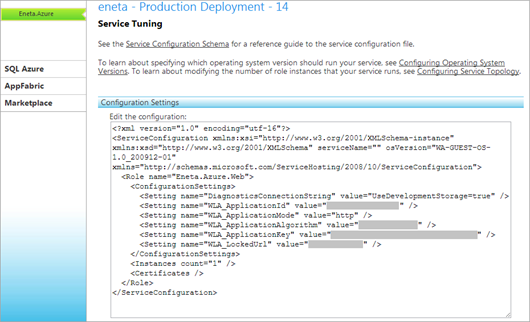Creating configuration reader for web and cloud environments
Currently it is not possible to make changes to web.config file that is hosted on Windows Azure. If you want to change web.config you have to deploy your application again. If you want to be able to modify configuration you must use web role settings. In this blog post I will show you how to write configuration wrapper class that detects runtime environment and reads settings based on this knowledge.
The following screenshot shows you web role configuration that is opened for modifications in Windows Azure site.
My solution is simple – I will create one interface and two configuration reading classes. Both classes – WebConfiguration and AzureConfiguration – implement IConfiguration interface.
C#using Microsoft.WindowsAzure.ServiceRuntime;
namespace MyWebApp
{
public interface IConfiguration
{
string GetSetting(string name);
}
public class AzureConfiguration : IConfiguration
{
public string GetSetting(string name)
{
return
RoleEnvironment.GetConfigurationSettingValue(name);
}
}
public class WebConfiguration : IConfiguration
{
public string GetSetting(string name)
{
return WebConfigurationManager.AppSettings[name];
}
}
}
Imports System.Web.Configuration
Imports Microsoft.WindowsAzure.ServiceRuntime
Namespace MyWebApp
Public Interface IConfiguration
Function GetSetting(ByVal name As String) As String
End Interface
Public Class AzureConfiguration
Implements IConfiguration
Public Function GetSetting(ByVal name As String) _
As String Implements IConfiguration.GetSetting
Return _
RoleEnvironment.GetConfigurationSettingValue(name)
End Function
End Class
Public Class WebConfiguration
Implements IConfiguration
Public Function GetSetting(ByVal name As String) _
As String Implements IConfiguration.GetSetting
Return WebConfigurationManager.AppSettings(name)
End Function
End Class
End Namespace
Now we need something that we can use to read configuration settings without worrying about what settings exactly are read. I write simple static class that detects configuration reader and reads configuration settings we ask.
C#using Microsoft.WindowsAzure.ServiceRuntime;
namespace MyWebApp
{
public static class Conf
{
private static IConfiguration _conf;
public static string GetSetting(string name)
{
if (_conf == null)
_conf = GetConf();
return _conf.GetSetting(name);
}
private static IConfiguration GetConf()
{
// If we are running in cloud
if (RoleEnvironment.IsAvailable)
return new AzureConfiguration();
return new WebConfiguration();
}
}
}
Imports Microsoft.WindowsAzure.ServiceRuntime
Namespace MyWebApp
Public Module Conf
Private Sub New()
End Sub
Private _conf As IConfiguration
Public Function GetSetting(ByVal name As String) As String
If _conf Is Nothing Then
_conf = GetConf()
End If
Return _conf.GetSetting(name)
End Function
Private Function GetConf() As IConfiguration
' If we are running in cloud
If RoleEnvironment.IsAvailable Then
Return New AzureConfiguration()
End If
Return New WebConfiguration()
End Function
End Module
End Namespace
We can use Conf.GetSetting(name) to read configuration parameters from currently active environment. Note how we are using RoleEnvironment to detect if we are in cloud. If you need the value of some setting you can just write code like this.
var appMode = Conf.GetSetting("WLA_ApplicationMode");
That’s it for now. As you can see it was not hard to extend our web application so we can read settings based on current environment. Static class is not maybe the best choice but it works for me. Now we have short and simple syntax for asking values of settings and if something changes we can make those changes to configuration classes and therefore we don’t have to modify classes that use those settings.

|
|
|
|
|
|
|
||||
